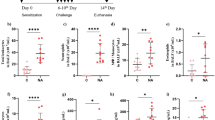Abstract
House dust mite is a major allergen in allergic diseases such as asthma. In this study, we investigated the effects of house dust mite on constitutive eosinophil apoptosis in normal and asthmatic subjects. We classified asthmatic subjects into those with atopic and non-atopic asthma depending on the presence of DP-specific IgE or/and DF-specific IgE in serum. Both blood and bronchoalveolar lavage fluid (BALF) eosinophils in atopic asthma were elevated when compared with normal and non-atopic eosinophils. Dermatophagoides pteronissinus extract (DP) inhibited constitutive eosinophil apoptosis of atopic asthmatic subjects, but not that of normal and non-atopic subjects. DF had no effect on eosinophil apoptosis in normal and asthmatic subjects. The anti-apoptotic effects of DP were not altered by E64, a cysteine protease inhibitor, or aprotinin, a serine protease inhibitor, and Der p1 and Der p 2 had no effect on eosinphil apoptosis of normal and asthmatic patients, including atopic and not-atopic patients. Anti-apoptotic signaling mediated by DP in atopic asthma was associated with the TLR4/PI3K/Akt/ERK/NF-κB pathway. Activation of procaspase 3 and procaspase 9 was delayed by DP stimulation. Our results indicate that DP induces eosinophilic inflammation by inhibiting eosinophil apoptosis, and that the inhibitory effect is associated with exposure of asthma subjects to DP. A better understanding of the difference between atopic and non-atopic asthma will help elucidate the pathogenesis and develop methods for treatment of asthma.
Similar content being viewed by others
References
Braman, S. S. The global burden of asthma. Chest 130: 4S-12S (2006).
Gould, H. J. & Sutton, B. J. IgE in allergy and asthma today. Nat Rev Immunol 8:205–217 (2008).
Holgate, S. T. Pathogenesis of asthma. Clin Exp Aller-gy 38:872–897 (2008).
Gaffin, J. M. & Phipatanakul, W. The role of indoor allergens in the development of asthma. Curr Opin Al-lergy Clin Immunol 9:128–135 (2009).
Gregory, L. G. & Lloyd, C. M. Orchestrating house dust mite-associated allergy in the lung. Trends Immu-nol 32:402–411 (2011).
Jacquet, A. The role of innate immunity activation in house dust mite allergy. Trends Mol Med 17:604–611 (2011).
Lee, J. S., Kim, I. S., Ryu, J. S. & Yun, C. Y. House dust mite, Dermatophagoides pteronissinus increases expression of MCP-1, IL-6, and IL-8 in human mono-cytic THP-1 cells. Cytokine 42:365–371 (2008).
Willart, M. A. & Lambrecht, B. N. The danger within: endogenous danger signals, atopy and asthma. Clin Exp Allergy 39:12–19 (2009).
Kawabata, A. & Kawao, N. Physiology and pathophys-iology of proteinase-activated receptors (PARs): PARs in the respiratory system: cellular signaling and physi-ological/pathological roles. J Pharmacol Sci 97:20–24 (2005).
Gould, H. J. & Sutton, B. J. IgE in allergy and asthma today. Nat Rev Immunol 8:205–217 (2008).
Wegmann, M. Targeting eosinophil biology in asthma therapy. Am J Respir Cell Mol Biol 45:667–674 (2011).
Simon, H. U. Cell death in allergic diseases. Apoptosis 14:439–446 (2009).
Ilmarinen, P. & Kankaanranta, H. Eosinophil apoptosis as a therapeutic target in allergic asthma. Basic Clin Pharmacol Toxicol 114:109–117 (2014).
Bianchi, S. M. et al. Granulocyte apoptosis in the path-ogenesis and resolution of lung disease. Clin Sci (Lond) 110:293–304(2006).
Thomas, W. R., Hales, B. J. & Smith, W. A. House dust mite allergens in asthma and allergy. Trends Mol Med 16:321–328 (2010).
Szalai, C., Ungvári, I., Pelyhe, L., Tölgyesi, G. & Falus, A. Asthma from a pharmacogenomic point of view. Br J Pharmacol 153:1602–1614 (2008).
Gent, J. F. et al. Association of pediatric asthma sever-ity with exposure to common household dust allergens. Environ Res 109:768–774 (2009).
Kim, E. H. et al. Regulation of constitutive neutrophil apoptosis due to house dust mite allergen in normal and allergic rhinitis subjects. PLoS One 9:e105814 (2014).
Yang, E. J. et al. Differential effect of CCL2 on consti-tutive neutrophil apoptosis between normal and asth-matic subjects. J Cell Physiol 227:2567–2577 (2012).
Kim, I. S. et al. Different anti-apoptotic effects of nor-mal and asthmatic serum on normal eosinophil apop-tosis depending on house dust mite-specific IgE. Mol Biol Rep 40:5875–5881 (2013).
Arlian, L. G. & Platts-Mills, T. A. The biology of dust mites and the remediation of mite allergens in allergic disease. J Allergy Clin Immunol 107:S406-S413 (2001).
Jeong, K. Y., Park, J. W. & Hong, C. S. House dust mite allergy in Korea: the most important inhalant allergen in current and future. Allergy Asthma Immunol Res 4: 313–325 (2012).
Akuthota, P., Xenakis, J. J. & Weller, P. F. Eosinophils: offenders or general bystanders in allergic airway dis-ease and pulmonary immunity? J Innate Immun 3:113–119 (2011).
Kankaanranta, H., Moilanen, E. & Zhang, X. Pharma-cological regulation of human eosinophil apoptosis. Curr Drug Targets Inflamm Allergy 4:433–445 (2005).
Ryu, J. H. et al. Distinct TLR-mediated athways regul-ate house dust mite-induced allergic disease in the upper and lower airways. J Allergy Clin Immunol 131:549–561 (2013).
Ilmarinen, P., Moilanen, E. & Kankaanranta, H. Regu-lation of spontaneous eosinophil apoptosis-a neglected area of importance. J Cell Death 7:1–9 (2014).
Author information
Authors and Affiliations
Corresponding authors
Rights and permissions
About this article
Cite this article
Kim, I.S., Im, M.A., Lee, N.R. et al. Different anti-apoptotic effects of house dust mite allergen on eosinophil apoptosis between atopic and non-atopic asthmatic subjects. Mol. Cell. Toxicol. 11, 193–200 (2015). https://doi.org/10.1007/s13273-015-0018-2
Received:
Accepted:
Published:
Issue Date:
DOI: https://doi.org/10.1007/s13273-015-0018-2




